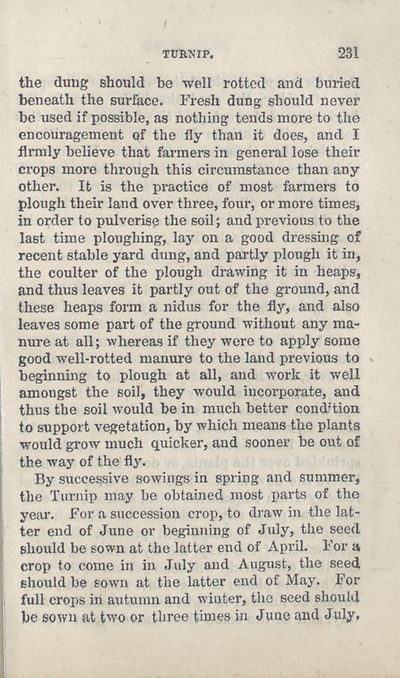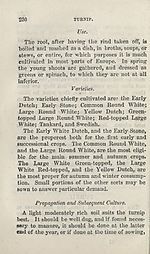Occupations > Abercrombie's improved practical gardener; with a monthly calendar for the flower garden
(235)
Download files
Complete book:
Individual page:
Thumbnail gallery: Grid view | List view

TURNIP.
231
the dung should be •well rotted and buried
beneath the surface. Fresh dung should never
be used if possible, as nothing tends more to the
encouragement of the fly than it does, and I
firmly believe that farmers in general lose their
crops more through this circumstance than any
other. It is the practice of most farmers to
plough their land over three, four, or more times,
in order to pulverise the soil; and previous to the
last time ploughing, lay on a good dressing of
recent stable yard dung, and partly plough it in,
the coulter of the plough drawing it in heaps,
and thus leaves it partly out of the ground, and
these heaps form a nidus for the fly, and also
leaves some part of the ground without any ma¬
nure at all; whereas if they were to apply some
good well-rotted manure to the land previous to
beginning to plough at all, and work it well
amongst the soil, they would incorporate, and
thus the soil would be in much better cond:tion
to support vegetation, by which means the plants
would grow much quicker, and sooner be out of
the way of the fly.
By successive sowings in spring and summer,
the Turnip may be obtained most parts of the
year. For a succession crop, to draw in the lat¬
ter end of June or beginning of July, the seed
should be sown at the latter end of April. For a
crop to come in in July and August, the seed
should be sown at the latter end of May. For
full crops in autumn and winter, the seed should
be sown at two or three times in June and July,
231
the dung should be •well rotted and buried
beneath the surface. Fresh dung should never
be used if possible, as nothing tends more to the
encouragement of the fly than it does, and I
firmly believe that farmers in general lose their
crops more through this circumstance than any
other. It is the practice of most farmers to
plough their land over three, four, or more times,
in order to pulverise the soil; and previous to the
last time ploughing, lay on a good dressing of
recent stable yard dung, and partly plough it in,
the coulter of the plough drawing it in heaps,
and thus leaves it partly out of the ground, and
these heaps form a nidus for the fly, and also
leaves some part of the ground without any ma¬
nure at all; whereas if they were to apply some
good well-rotted manure to the land previous to
beginning to plough at all, and work it well
amongst the soil, they would incorporate, and
thus the soil would be in much better cond:tion
to support vegetation, by which means the plants
would grow much quicker, and sooner be out of
the way of the fly.
By successive sowings in spring and summer,
the Turnip may be obtained most parts of the
year. For a succession crop, to draw in the lat¬
ter end of June or beginning of July, the seed
should be sown at the latter end of April. For a
crop to come in in July and August, the seed
should be sown at the latter end of May. For
full crops in autumn and winter, the seed should
be sown at two or three times in June and July,
Set display mode to:
![]() Universal Viewer |
Universal Viewer | ![]() Mirador |
Large image | Transcription
Mirador |
Large image | Transcription
| Antiquarian books of Scotland > Occupations > Abercrombie's improved practical gardener; with a monthly calendar for the flower garden > (235) |
|---|
| Permanent URL | https://digital.nls.uk/121884039 |
|---|
| Description | Thousands of printed books from the Antiquarian Books of Scotland collection which dates from 1641 to the 1980s. The collection consists of 14,800 books which were published in Scotland or have a Scottish connection, e.g. through the author, printer or owner. Subjects covered include sport, education, diseases, adventure, occupations, Jacobites, politics and religion. Among the 29 languages represented are English, Gaelic, Italian, French, Russian and Swedish. |
|---|

